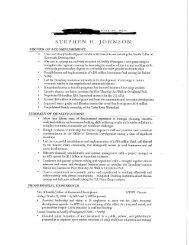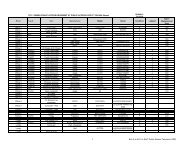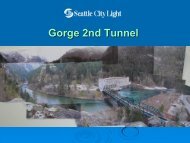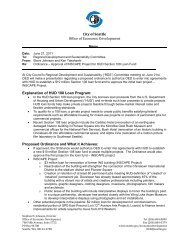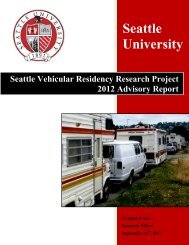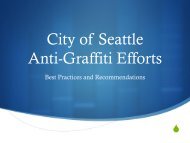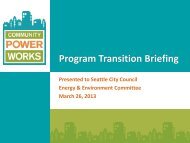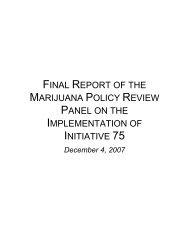2013 Water System Plan, Volume II - Seattle City Clerk's Office - City ...
2013 Water System Plan, Volume II - Seattle City Clerk's Office - City ...
2013 Water System Plan, Volume II - Seattle City Clerk's Office - City ...
You also want an ePaper? Increase the reach of your titles
YUMPU automatically turns print PDFs into web optimized ePapers that Google loves.
C. Mitigation of Damaged <strong>Water</strong> Mains<br />
When vibration monitoring is required, SPU will perform a pre- and post-construction<br />
acoustic leak survey of the existing water lines near the construction activities. If<br />
damage or leaking increases and is determined to be caused by the construction<br />
activities, the RE will send a written request to the contractor to restore damaged or<br />
destroyed property to its original condition. The contractor, not the owner or <strong>City</strong> of<br />
<strong>Seattle</strong>, must pay for and the repair or replacement of the pipe according to <strong>City</strong><br />
Standard Specifications.<br />
5.10.2 Removal and Abandonment of Existing <strong>Water</strong><br />
Mains and Appurtenances<br />
The following are SPU standards:<br />
1. Where required for water main projects, removal of existing water mains and<br />
appurtenances must meet the requirements of Standard Specification 2-02.3(7)B.<br />
2. All ends of abandoned water mains must be plugged. Pipes 12 inches or larger in<br />
diameter must be abandoned and filled in accordance with Standard Specification 2-<br />
02.3(5).<br />
3. <strong>Water</strong> pipes designated on project drawings to be abandoned and filled must be<br />
filled with pumpable, flowable cement slurry that completely fills the pipe (Standard<br />
Specification 9-05.15).<br />
4. After the record drawings (as-builts) have been incorporated into GIS, the design<br />
engineer must check that the abandoned pipe is properly shown.<br />
5.10.2.1 Considerations for Disposal of Hazardous Materials<br />
The design and specifications of projects that remove or abandon water facilities must identify<br />
pipes that are known to have or may have hazardous materials. The contractor needs this<br />
information to calculate the costs for special handling and disposal. The most commonly found<br />
hazardous materials in SPU’s water system and considerations for their mitigation or removal<br />
are described in Table 5-12.<br />
Table 5-12 Hazardous Materials associated with SPU <strong>Water</strong> <strong>System</strong><br />
Material Prevalence in <strong>System</strong> Mitigation/Removal<br />
Asbestos Cement Pipe<br />
Lead Joints<br />
Coal Tar-Lined and<br />
Coated Steel Pipe<br />
Commonly used in water mains installed in<br />
1940s and 50s. Uncommon now<br />
Almost all joints in older cast iron pipe have<br />
lead seals. Most of SPU’s distribution system<br />
is cast iron w/ lead joints and can be expected<br />
to have decades useful service if not physically<br />
disturbed<br />
SPU has coal tar coatings and or linings in the<br />
Cedar River Pipeline <strong>System</strong> as well as a few<br />
other steel pipes<br />
Avoid removal and abandon in-place<br />
where possible. If removal is<br />
necessary, containment and filtration<br />
requirements must follow OSHA and<br />
WISHA<br />
Recycled by crews for other crew<br />
work<br />
If removed, disposal to a licensed<br />
hazardous waste landfill. Working and<br />
handling of coal tar materials must<br />
follow OSHA and WISHA standards.<br />
5-66 SPU Design Standards and Guidelines



